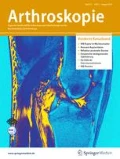Zusammenfassung
Einleitung
Der vorliegende Artikel beschreibt eine arthroskopische Rekonstruktion des vorderen Kreuzbands (VKB) mit einem autologen Quadrizepssehnentransplantat in anteromedialer Portaltechnik.
Material und Methoden
Zunächst wird ein 5 cm langer Sehnenstreifen mit einem 2 cm langen Knochenblock entnommen. Der femorale Tunnel wird über ein tiefes anteromediales Portal in anatomischer Position angelegt. Der tibiale Tunnel wird mit einer Hohlfräse angelegt, so dass ein freier Knochenzylinder gewonnen wird. Das Transplantat wird durch den tibialen Tunnel eingezogen und der Knochenblock, welcher an der Spitze keilförmig präpariert wurde, wird über das anteromediale Portal eingestößelt, um eine Press-fit-Fixation zu erzeugen. Die Armierungsfäden des freien Sehnenendes des Transplantats werden über einer Knochenbrücke am distalen Ende des tibialen Tunnels fixiert. Von dem bei der tibialen Tunnelanlage gewonnenen zylindrischen Knochenblock wird ein proximales Teilstück abgetrennt und vorsichtig gelenknah neben das Transplantat in den tibialen Tunnel gestößelt, um auch tibial eine Press-fit-Fixation zu erzeugen. Der distale Anteil des tibialen Bohrkanals wird mit dem restlichen Knochen aufgefüllt.
Ergebnisse und Schlussfolgerung
Die dargestellte Technik ist reproduzierbar und zeigt gute klinische Ergebnisse in den frühen Follow-up-Untersuchungen. Der Vorteil liegt in dem minimalen knöchernen Defekt, insbesondere femoral, sowie in der implantatfreien Fixierung. Die Verwendung eines Quadrizepssehnentransplantats erhält die dynamische Funktion der Hamstring-Sehnen für die Stabilisierung des Kniegelenks gegen Valgusstress.
Abstract
Introduction
This article describes an arthroscopic anterior cruciate ligament (ACL) reconstruction technique with a quadriceps tendon autograft using an anteromedial portal technique.
Material and methods
A 5 cm long quadriceps tendon graft is harvested together with an adjacent 2 cm bone block. The femoral tunnel is created in its anatomical position through a deep anteromedial portal. The tibial tunnel is created with a hollow burr, thus acquiring a free cylindrical bone block. The graft is then passed through the tibial tunnel and the bone block customized at its tip and tapped into the femoral tunnel through the anteromedial portal to provide press-fit fixation. The graft is tensioned distally and sutures are tied over a bone bridge at the distal end of the tibial tunnel. From the cylindrical bone block harvested from the tibia the proximal end is customized and gently tapped next to the graft tissue into the tibial tunnel to also assure press fitting of the graft in the tibial tunnel. The distal part of the tibial tunnel is filled with the remaining bone.
Results and conclusion
This technique presented was shown to be reproducible and to achieve good clinical results at the early follow-up examination. Potential advantages include minimum bone loss specifically on the femoral side and fixation without implants. The use of a quadriceps tendon graft preserves the dynamic function of the hamstring tendons for stabilization of the knee joint against valgus stress.







Literatur
Akoto R, Muller-Hubenthal J, Balke M, Albers M, Bouillon B, Helm P, Banerjee M, Hoher J (2015) Press-fit fixation using autologous bone in the tibial canal causes less enlargement of bone tunnel diameter in ACL reconstruction—a CT scan analysis three months postoperatively. Bmc Musculoskelet Disord 16:200. https://doi.org/10.1186/s12891-015-0656-5
Barie A, Kargus S, Huber J, Schmitt H, Streich NA (2010) Anterior cruciate ligament reconstruction using quadriceps tendon autograft and press-fit fixation. Unfallchirurg 113(8):629–634. https://doi.org/10.1007/s00113-010-1854-0
Boszotta H (1997) Arthroscopic anterior cruciate ligament reconstruction using a patellar tendon graft im Druck-fit technique: surgical technique and follow-up. Arthroscopy 13(3):332–339
Geib TM, Shelton WR, Phelps RA, Clark L (2009) Anterior cruciate ligament reconstruction using quadriceps tendon autograft: intermediate-term outcome. Arthroscopy 25(12):1408–1414. https://doi.org/10.1016/j.arthro.2009.06.004
Harner CD, Honkamp NJ, Ranawat AS (2008) Anteromedial portal technique for creating the anterior cruciate ligament femoral tunnel. Arthroscopy 24(1):113–115
Herbort M, Michel P, Raschke MJ, Vogel N, Schulze M, Zoll A, Fink C, Petersen W, Domnick C (2017) Should the Ipsilateral hamstrings be used for anterior cruciate ligament reconstruction in the case of medial collateral ligament insufficiency? Biomechanical investigation regarding dynamic stabilization of the medial compartment by the hamstring muscles. Am J Sports Med 45(4):819–825. https://doi.org/10.1177/0363546516677728
Hertel P, Behrend H, Cierpinski T, Musahl V, Widjaja G (2005) ACL reconstruction using bone-patellar tendon-bone press-fit fixation: 10-year clinical results. Knee Surg Sports Traumatol Arthrosc 13(4):248–255. https://doi.org/10.1007/s00167-004-0606-5
Paessler HH, Mastrokalos DS (2003) Anterior cruciate ligament reconstruction using semitendinosus and gracilis tendons, bone patellar tendon, or quadriceps tendon-graft with press-fit fixation without hardware. A new and innovative procedure. Orthop Clin North Am 34(1):49–64
Akoto, Hoeher (2012) BMC Musculoskelet Disord 13:161 (http://www.biomedcentral.com/1471-2474/13/161, Open Access)
Danksagung
Die Autoren haben diese Operationstechnik auf der Basis der Technik von Dr. Jürgen Huber, Heidelberg, weiterentwickelt. Wir danken Herrn Hans-Jörg Schütze für die Erstellung der medizinischen Abbildungen der Operationstechnik.
Author information
Authors and Affiliations
Corresponding author
Ethics declarations
Interessenkonflikt
J. Höher und R. Akoto geben an, dass kein Interessenkonflikt besteht.
Dieser Beitrag beinhaltet keine von den Autoren durchgeführten Studien an Menschen oder Tieren.
Rights and permissions
About this article
Cite this article
Höher, J., Akoto, R. Vorderer Kreuzbandersatz mit autologem Quadrizepssehnentransplantat und Press-fit-Fixation. Arthroskopie 31, 215–220 (2018). https://doi.org/10.1007/s00142-018-0203-0
Published:
Issue Date:
DOI: https://doi.org/10.1007/s00142-018-0203-0

